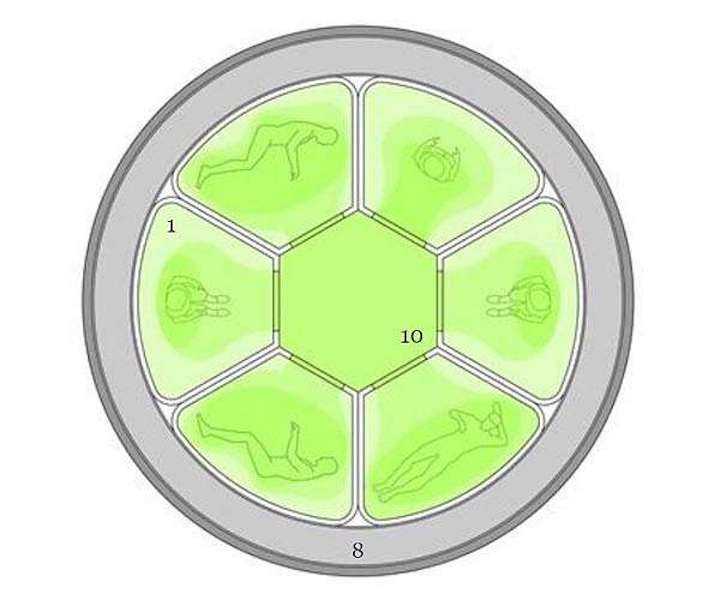19.11.2019

A cross-section through the hibernation module showing the individual quarters that would double as hibernation pods during the cruise phase. The soft-shelled pods would have individual thermal controls and flexible insulation, with a fan to circulate air and control humidity to prevent condensation when the temperature is reduced during hibernation. The pods would also be well shielded against radiation. (1)private crew quarters, (8) life support system and stowage, (10) circulation space.
If a sci-fi spaceship does not come with hyperdrive then it is usually fitted with hibernation capsules instead. In movies from 2001: A Space Odyssey to Event Horizon, Alien to Passengers, fictional astronauts get put into 'suspended animation' to cross the vastness of space. Now ESA has investigated how real life crew hibernation would impact space mission design.
Human hibernation has been the subject of initial research within the Discovery element of ESA's Basic Activities, then recommended as a key 'enabling technology' for space by the Agency's Future Technology Advisory Panel, resulting in a dedicated 'Topical Team' on hibernation.
Now the Agency's SciSpacE team has called in ESA's Concurrent Design Facility - a multimedia facility enabling expert teams to perform initial evaluations of proposed future missions - to assess the advantages of human hibernation for a trip to a neighbouring planet, such as Mars.
Beginning with an assessment on the current state of the art in human hibernation, with the help of ESA Topical Team scientists from Ludwig Maximilian University of Munich and the University of Goethe, Frankfurt, the CDF team went to investigate for the first time the potential impact of hibernation on system-level mission design. They took as their reference an existing mission study to send six humans to Mars and back in a five year timescale.
"We worked on adjusting the architecture of the spacecraft, its logistics, protection against radiation, power consumption and overall mission design," comments Robin Biesbroek of the CDF.
"We looked at how an astronaut team could be best put into hibernation, what to do in case of emergencies, how to handle human safety and even what impact hibernation would have on the psychology of the team. Finally we created an initial sketch of the habitat architecture and created a roadmap to achieve a validated approach to hibernate humans to Mars within 20 years."
The study found the spacecraft mass could be reduced by a third by removing the crew quarters with a similar reduction in consumables, equivalent to several tons of saved mass. Hibernation would take place in small individual pods that would double as cabins while the crew are awake.
The assumption was that a drug would be administered to induce 'torpor' - the term for the hibernating state. Like hibernating animals, the astronauts would be expected to acquire extra body fat in advance of torpor. Their soft-shell pods would be darkened and their temperature greatly reduced to cool their occupants during their projected 180-day Earth-Mars cruise.
The hibernating cruise phase would end with a 21 day recuperation period - although based on the experience of animal hibernation, the expectation would be that the crew would not experience bone or muscle wastage.
Radiation exposure from high-energy particles is a key hazard of deep space travel, but because the hibernating crew will be spending so much time in their hibernation pods, then shielding - such as water containers - could be concentrated around them. And existing research into hibernation shows it gives enhanced radiation protection in its own right.
But with all the crew incapacitated for extended periods of time, the mission would have to be designed for largely autonomous operations, with optimum use of artificial intelligence and 'fault detection, isolation and recovery' to maintain a minimum level of system performance until the crew could be revived.
"For a while now hibernation has been proposed as a game-changing tool for human space travel," explains SciSpacE Team Leader Jennifer Ngo-Anh. 'If we were able to reduce an astronaut's basic metabolic rate by 75% - similar to what we can observe in nature with large hibernating animals such as certain bears - we could end up with substantial mass and cost savings, making long-duration exploration missions more feasible.
"And the basic idea of putting astronauts into long-duration hibernation is actually not so crazy: a broadly comparable method has been tested and applied as therapy in critical care trauma patients and those due to undergo major surgeries for more than two decades. Most major medical centres have protocols for inducing hypothermia in patients to reduce their metabolism to basically gain time, keeping patients in a better shape than they otherwise would be.
"We aim to build on this in future, by researching the brain pathways that are activated or blocked during initiation of hibernation, starting with animals and proceeding to people."
Quelle: SD
